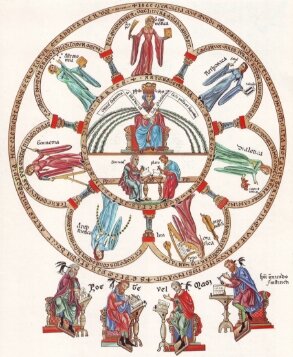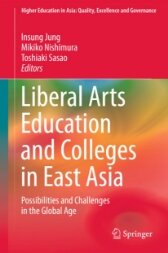Reading a History of Liberal Arts Education
ICU is a pioneer of liberal arts colleges in Japan.
Take a look at the historical background of liberal arts education which ICU emphasizes.

A modern liberal arts education seeks to nurture students with character and a deep understanding of humanity. The roots of modern liberal arts education lie in the seven liberal arts (music, arithmetic, geometry and astronomy, grammar, logic, and rhetoric) which freeman studied in late Classical and Hellenistic Greece.
The roots of the seven liberal arts
Classical and Hellenistic Greece where it enabled citizens to contribute to civic life.
"Raphael's The School of Athens" is marked with CC0 1.0.
Curriculum in Roman Era
The four 'scientific' artes - music, arithmetic, geometry and astronomy (or astrology) - known as the Quadrivium were featured in the formal education of the Roman Empire. After the 9th century, these were joined by the Trivium, the three arts of the 'humanities' (grammar, logic, and rhetoric) to form the seven liberal arts studied in the universities of medieval Europe.
Development of Trivium
During the Renaissance, the Italian humanists and their Northern counterparts renamed the old Trivium Studia humanitatis, downplaying logic and adding history, Greek, and moral philosophy (ethics).
Foundation of education in Europe
The 16th century saw this curriculum of humanism spread throughout Europe to become the foundation for educating the European elites, political administrators, clergy, and those studying the professions of law and medicine.
A liberal arts education was seen as liberating, granting freedom to study and enabling graduates to contribute to civic life.
To the US in 17th century
In the 17th century, liberal arts education tradition was then taken up in the US
Liberal Arts Education in the US
This liberal arts education tradition was then taken up in the US where it has long been a feature of small, private, liberal arts colleges. The first residential liberal arts colleges of Harvard and William and Mary were established in 1636 and 1693 respectively and Yale's roots go back to the 1640s. Small-scale independent liberal arts colleges continued to develop throughout the 18th and 19th centuries and became the initial force of US higher education.
Challenges Faced by Liberal Arts Colleges
Rising demand for practical, vocational education in the US in the end of 19th century pushed liberal arts colleges to adapt to changes
Rising demand for practical education
The end of the 19th century saw the development of new forms of higher education institutions such as the large-scale public and research universities and technical and vocational schools and as a result, the growth of the small, residential liberal arts colleges decreased (Ferrall, 2011). However, despite the rising demand for practical, vocational education, several of the oldest, private liberal arts colleges continue to thrive and attract first-class students and achieve high listings in the university rankings.
Challenges of Liberal Arts Colleges
To respond to the rapidly changing 21st century, liberal arts colleges adapted in creative and flexible ways. First, liberal arts colleges have added vocational degrees to their offerings. Second, many liberal arts colleges have developed various collaborative relationships such as the Global Liberal Arts Alliance which was established in 2009. Liberal arts colleges were able to compete with highly-renowned research universities for the best students by collaboration and adapting and strengthening their offerings in flexible ways.
Back to Europe
The end of 20th century saw a revival of liberal arts education in Europe
Revival of Liberal Arts Education
De-regulation and the Bologna Process in Europe have contributed to the revival of US liberal arts in the European countries since the 1960s with the founding of private independent liberal arts colleges such as the American University of Paris and the American University of Rome. Since then, several other independent colleges and programs have been established within large universities, including the recently founded Amsterdam University College in the Netherlands, and liberal arts programs at University College London and King's College London in the UK.
Now to Asia
The concepts and practices of liberal arts education spread to Asia and becomes a global standard
Spread to Asia after World War II
While the first encounter with these ideas and methods goes right back to the mid-19th century, the full-scale implementation of the concepts and practices of liberal arts education into East Asian higher education started after the Pax Americana following World War II. ICU is one of the pioneering liberal arts colleges in East Asia, founded in 1953. From the mid-1990s onwards, liberal arts programs were being offered in English language in East Asia, particularly in Japan and China. Thus, liberal education emerged gradually to Asia
New development of liberal arts education in contemporary Asia
In East Asian countries, particularly in Japan, South Korea, Taiwan and China, higher education is showing an increased interest in liberal arts education and these countries have also seen the establishment of liberal arts colleges and programs. Some well-known, small-scale independent liberal arts colleges in Asia with different historical backgrounds include: International Christian University and Miyazaki International College (Japan), Handong Global University (S. Korea), Lingnan University (Hong Kong), Flame University (India), and Asian University forWomen (Bangladesh).
The Concepts of Liberal Arts Education
From Roman Empire to Europe, the US, and Asia. The universal concepts and its approach are defined.
Concepts of Liberal Arts Education
The Association of American Colleges and Universities (AACU, n.d.) defines liberal arts education as "an approach to learning that empowers individuals and prepares them to deal with complexity, diversity, and change [and provides] students with broad knowledge of the wider world (e.g. science, culture, and society) as well as in-depth study in a specific area of interest."In general, three key values are considered essential in liberal arts education as argued in Chopp, a former AAC&U board member (2014).
1."Critical thinking"
which involves analyzing phenomena, asking difficult questions and formulating possible answers, developing logical, well-evidenced arguments, and evaluating and refining these answers and arguments. To develop critical thinking skills, liberal arts education emphasizes the importance of small group discussions and debates and study in the broad contexts of literature, languages, history, music, arts, philosophy, psychology, mathematics and the sciences.
2."Moral" and "civil character"
which involves developing moral habits and good citizenship in students by means of extra-curricular and community-based activities, student-student and faculty-student interaction, and on-campus residential experiences.
3."Using knowledge" to improve the world or service to the world by encouraging
students to explore interrelationships within their majors and other courses and between their on-campus and off-campus experiences and to reflect on the wider social and global contexts of their learning. They are expected to work cooperatively in teams or with people from different disciplines or cultures and to discuss and resolve issues from diverse perspectives. Besides these principles, curiosity, creativity, critical self-reflection, a sense of social responsibility and communication skills have been emphasized in liberal arts education.
Importance of Liberal Arts Education in the Knowledge Society
We live in an increasingly complex and interconnected, knowledge society. The further development of the knowledge society wherein knowledge and education are perceived as a productive asset has become a national priority for many countries around the world. It has become more critical than before that universities develop foundational knowledge and skills in their students and cultivate them as leaders who can see the big picture with profound comprehension in more than just one specialized area, and who can make sound decisions in society. In this regard, a liberal arts education is practical in today's society.
Doing Liberal Arts Education at ICU
As Japan's pioneer liberal arts university, ICU's foremost educational principle has been that "liberal arts shall be the basis for all activities at ICU." Based on this principle, ICU has a strong focus on critical thinking, democratic citizenship, problem-solving, free exchange of ideas, learning across disciplinary boundaries, and knowledge for its own sake. The spirit of liberal arts education is most firmly integrated in ICU's general education curriculum, bilingual programs, and recent globalization projects.
Parts of this section were developed based on Chapters 1 and 5 in Jung, I., Nishimura, M., & Sasao, T. (Eds.), Liberal arts education and colleges in East Asia. Springer.





